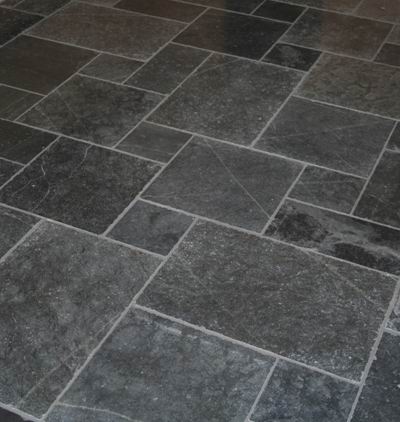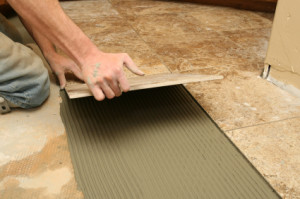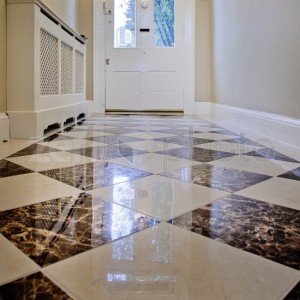When thinking about laying a new tiled floor then no decision is complete without considering the merits of natural stone. Ceramic tiles or porcelain tiles may be easier to maintain but can never match the unique beauty of natural stone.
If you currently have a ceramic tiled floor or even porcelain tiles, you will know that they look good and are easy to maintain but if you are thinking about changing the design of your room (or just the flooring), whether it is your kitchen, bathroom, hallway or conservatory, then no decision will be complete without considering natural stone tiles as an option.
You may think your budget will not stretch to natural stone but they are available in a range of prices so don’t discount them until you have checked out what’s available. But before thinking about the cost, why would you want to choose natural stone in the first place?
Flooring is a key design element in any home that can set the whole tone of a space, but it is not easy or cheap to replace and often needs to fit with a range of styles should you decide to alter your décor over time. So it is important for both design and cost consequences that you make the right choice first time.
Natural stone is beautiful and durable with individual characteristics that simply can’t be matched by mass-produced ceramic or porcelain tiles, which are all the same and offer no interest to the viewer. Certainly porcelain tiles now come in “natural stone” effect but these are usually poor imitations of the real thing because they do not contain the natural variations and slight imperfections that make natural stone so unique.
But even though stone tiles are durable, they do need good, thorough maintenance and will need to be sealed with an appropriate sealant after installation. You will be able to get advice from a reputable supplier about the particular products best suited to different types of stone.
But more importantly than all of this is the look of the tiles and your own personal preference about what sort of design statement you want to make. Will it be ultra-contemporary, traditional, rustic or classically understated? All of these personal preferences will influence your choice. Marble is perfect for a classic, luxurious look or slate for the ideal rustic flooring in a country cottage. Highly polished limestone creates a contemporary feel and some travertine floor tiles manage to combine elegance with a rustic edge. All are impressive.
Don’t forget to think about how the colour of the floor will complement your furniture, fittings, accessories and artwork. Pale golden limestone floor tiles are a perfect background for a neutral design scheme or a bolder one using bright colours. On the other hand dark slate tiles or black marble will define the design scheme and can mean that other items in a room have to be chosen carefully to avoid the scheme becoming over-dark (or worse, drab and depressing).
But natural stone is versatile and can look great anywhere providing the style and colour is selected carefully to suit your own personal style of interiors. It can be a key element that creates harmony between a number of different rooms.
Thinking About Marble? Possibly the Best Natural Stone Floor Tiles
If you have the budget to splash out on marble tiles you will not regret it. They have a unique beauty that simply cannot be matched by any other type of tiles.
Many people when they buy a property and move house for the first time will not have a huge budget to splash out on luxuries like natural stone, solid wood floors and designer furniture and accessories so they will typically choose lower end products that can still be used to create a beautiful home without the expense. But what if you have been through this process before (maybe many times) where you sacrificed quality for cost?
If you have chosen less expensive alternatives for flooring, for example, then you are likely to have discovered over time that the cheaper options simply do not last as long or wear as well. They also tend to be products in fashionable colours or finishes that date quickly. Laminate wood floors will start to peel at the edges and slate effect tiles will chip to reveal that the colour does not go right through the body of the tile.
So it’s true that you get what you pay for but sometimes we simply don’t have the choice to spend what we want on a flooring product for our home. But if you are now in a position to choose the very best products and are determined to no longer sacrifice quality for cost then there is nothing better than natural stone floor tiles; it is both beautiful and hard-wearing.
One of the best things about a natural stone floor is the individual characteristics and distinctive colours apparent in each tile. But there are so many different varieties of natural stone that it is sometimes difficult to make a choice. The is travertine, slate, marble or limestone as well as a whole range of more unusual stones and they all come in different finishes and naturally different colours.
Take marble, for example, most people know about the beautiful, fine Carrara marble from Italy with its pure white background complemented by veining in a variety of shades and quantity. The colour and amount of veining is the main factor in deciding the quality and, of course, the cost. Pure white marble tiles are the most sought-after and the most expensive whereas marble tiles with plenty of veining are cheaper although many people like the beauty of the veining and the fact that it shows that the tiles are real marble.
There are also a number of well-regarded marbles from Spain such as Marfil marble, which, like Italian marble, is graded and categorised according to the amount and type of veining and other variations within the finished stone floor tiles. Those with the least veining are again the most expensive but, as with Carrara marble tiles, cheaoer versions are often just as attractive, particularly if you like the natural variations and characteristics across individual tiles.
If money really is no object then there are also some very rare forms of marble that are quite outstanding, such as the black Marquina marble from Italy. But, equally, there are other less well known types of marble in a range of colours and for prices to suite a variety of budgets. You might be considering ceramic tiles for their good value or porcelain tiles for their ease of maintenance but if you are seeking a truly distinctive look then nothing beats marble wall or floor tiles.
What about Terracotta Tiles?
Traditional unglazed terracotta tiles require regular, time-consuming maintenance but glazed terracotta offers all the charm and beauty of the material without the maintenance headache. All thanks to technological advances in their manufacture.
Traditionally made terracotta tiles are, without doubt, beautiful but many people are discouraged from using them in their homes because they are concerned about the high levels of maintenance required to keep them looking good. The thought of sealing the tiles regularly can be a deterrent to many people especially when there are contemporary alternatives such as porcelain tiles which require minimal maintenance, if any.
But there are, in fact, two types of terracotta tiles manufactured now: the more typical unglazed tiles, which do, indeed, require extensive maintenance, but also glazed tiles which require minimal maintenance.
Unglazed terracotta has been used in private homes extensively in the past although it is now less popular simply due to the change in interior trends. The type of maintenance that it required was treatment with linseed oil and wax or sealing with a synthetic sealant. The traditional oil and wax method involved applying several coats of linseed oil with a soft cloth after the tiles were laid but before the grouting was done. The oil would darken the natural terracotta colour and once dry the routing was done and was followed by a coat of clear wax. The disadvantage of this method was that the wax needed to be reapplied regularly to maintain the sheen and would eventually have to be stripped off and the waxing process started again. Understandably this is the process that deters people from using terracotta.
The less traditional approach requires applying several coats of a synthetic sealant which can last for up to 3 years and never needs to be stripped back as it can just be applied over the existing sealer to revitalise the finish.
However, neither approach could be termed “low-maintenance” but, fortunately, for those who love the rustic charm and warm tones of terracotta some manufacturers are now manufacturing glazed terracotta tiles which genuinely are low maintenance.
All terracotta tiles are made from a workable mixture of clay and water that is shaped as required and then left to dry naturally before being fired in a kiln. Whilst the technique is ancient there have been considerable improvements in its implementation due to technological advances which have enabled terracotta tiles to be created with a glazed surface.
The clay used to make terracotta tiles is extracted from a quarry and grinding machines are usually used to reduce the clay to a powder. The water is then added to form a paste and the tiles can either be created by hand, for a more rustic look, or by machine, for a sleeker, more modern look.
Once dry the kiln-firing of the tiles is done with the high temperatures making a tougher, more stable glazed terracotta tile. Because of the high-temperature glazing these types of tiles need none of the tedious maintenance procedures that the more traditional, unglazed tiles require. Yet they have the look and feel of a hand made tile with natural variations in colour adding to their unique beauty without the maintenance headache.
Glazed terracotta tiles are typically supplied in batches that have a range of colours within the same colour spectrum to ensure your floor will never look bland and “too perfect”. Mass produced ceramic tiles or porcelain tiles can never achieve this type of unique beauty because every tile is the same.
A few final considerations:
- Safety – remember that highly polished surfaces can be slippery when wet so may not be the best choice in bathrooms or wetrooms.
- Samples – make sure to view samples in your own home under your own lighting conditions (not the bright lights of a showroom)
- Cost – shop around for bulk buys, discontinued lines and special purchases of natural stone. You won’t regret choosing them









